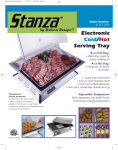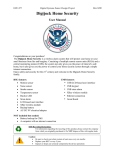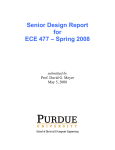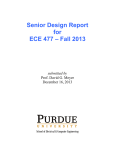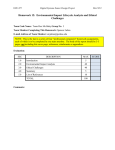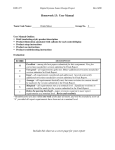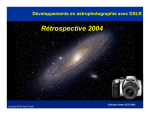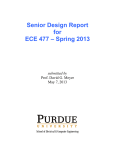Download ECE 477 Callout Information Session Slides
Transcript
SENIOR DESIGN INFO SESSION INTRODUCTION TO ECE 477 George Hadley ©2014, Images Property of their Respective Owners. COURSE OVERVIEW Course Description: A structured approach to the development and integration of embedded hardware, software, and firmware that provides students with significant design experience applying microcontrollers to a wide range of embedded systems. Objective: To provide practical experience developing integrated hardware and software which students will encounter in industry. COURSE STAFF • George Hadley ([email protected]) Course Coordination and Development • David Meyer ([email protected]) Professor-In-Charge / Spring Lecture Professor • Mithuna Thottethodi ([email protected]) Fall Lecture Professor • Joseph Bougher ([email protected]) Digital Systems Laboratory Engineer • Mark Johnson ([email protected]) Director of Instructional Labs Additional details can be found under the website About Staff tab COURSE OVERVIEW Lectures: Tuesdays and Thursdays Topics include professional and design components Lecture dates and topics listed on Course Calendar Mandatory Lab Hours: Wednesdays (two sections available – all four team members must register for the same section) Used to assess progress, provide feedback, and improve student/staff communication COURSE OVERVIEW Midterm Design Review and Final Presentation: Formal presentations given before classmates, course staff, and project sponsors Opportunity to showcase prototyping progress and final deliverables Weekly Progress Updates: Used to detail individual design activities and progress Evaluated numerous times throughout the semester (one of the five course outcomes) ECE Design Showcase: Opportunity to showcase completed projects to students, faculty, and project sponsors DESIGN PROJECT Teams: Four students each (no exceptions), self-selected Established prior to submission of project proposal Projects: Open-ended, team-specified and of personal interest to at least two team members Tractable, yet “difficult enough” Must satisfy five general and five project-specific success criteria Opportunity to develop communication and teamwork skills that will be needed in industry DESIGN PROJECT Basic Project Specifications: Must utilize a programmable chip (Arduinos are acceptable for prototyping purposes but are not accepted for final project submissions) May also utilize a CPLD or FPGA May also utilize a “motherboard” (Atom / ARM / R-Pi) Must interface to multiple systems (sensor, keypad, LCD, GPS, etc.) using multiple standard interfaces (USB, Ethernet, I2C, RS232, IR, RF, etc.) Requires the design and fabrication of a two-layer custom printed circuit board (PCB) Must be neatly packaged and integrated COURSE SCHEDULE/CALENDAR Weeks 1-4: Concept Development: • Functional Project Proposal: “Our idea seems sound… what do we need to get started?” • Functional Analysis: “How will our project be used? What are our project’s requirements?” • Electrical and Software Overviews: “At a high level, how will our project function?” • Component Analysis and Bill of Materials: “What parts does our project need to use?” • Ordering/Acquisition of parts, tools, and prototyping hardware COURSE SCHEDULE/CALENDAR Weeks 5-9: Design: • Mechanical Overview: “What will our project look like? What form factor does it need to fit within?” • Software Formalization: “What software components will our design use? How will we verify and test the software?” • Printed Circuit Board Layout • Midterm Design Review • PCB Submission and Verification COURSE SCHEDULE/CALENDAR Weeks 10-15: Testing and Integration: • Legal Analysis: “What steps must be taken to ensure our project can be legally sold to our customers?” • Reliability and Safety Analysis: “What risks are associated with use of our product? What parts are most likely to fail?” • Ethical and Environmental Analysis: “What resources does our project use? How can we responsibly manage our project’s life cycle? What ethical issues does our project present?” • User Manual: Guide to your project for the end user Week 16: Success Criteria Demos, Final Presentations, and Final Documentation COURSE WEBSITE https://engineering.purdue.edu/ece477 • About – general course overview, staff information, history • Course – assignments, lectures, documents, policies, processes • Teams – information about current teams and links to their project websites • Archive – information about past teams and links to websites • Sponsors – information for corporate sponsors • Incoming – registration information for prospective students • Contact – course account email link for communications Sample Past Projects ECE 477 Digital Systems Senior Design Project Spring 2007 SOUNDS GOOD / DS3 Digital Steerable Sound System Joe Land, Ben Fogle, James O’Carroll, Elizabeth Strehlow PROJECT DESCRIPTION: USER MENUS CONCEPT: USER INTERFACE UNIT: -Digitally Steerable Sound System, allows for non-ideal placement of speakers -Six Preset Equalization Modes -Wireless Control Interface PCB LAYOUT: ILLUSTRATION OF CONCEPT: LOUDSPEAKER UNIT: Top Copper Bottom Copper SIGNAL PATH: FRONT Digijock(ette)-Strength Digital System DesignTM BACK ECE 477 Digital Systems Senior Design Project Fall 2007 Team 2: Hooked on Harmonix Final Printed Circuit Board (PCB) Hooked on Harmonix is a learning tool that teaches the user valuable piano skills while providing an entertaining experience at the same time. 4-layer Printed Circuit Board (PCB) Synopsis: The user selects one of several MIDI tracks stored in Flash memory, and the corresponding file is parsed outputting bars of appropriate length to a standard computer monitor. Performance from a standard MIDI keyboard is judged and graded when the song is finished. I/O Ports (from left): Audio Output, VGA output, MIDI input, power input User input from standard MIDI keyboard is compared to stored MIDI song file Digijock(ette)-Strength Digital System DesignTM ECE 477 Digital Systems Senior Design Project Spring 2008 Design Device RoboRubik Block Diagram Tyler Heck Dave Bukiet Erik Carron Casey Kloiber RoboRubik is a self-contained automated Rubik's Cube solver. You can scramble and solve it just like a normal Rubik’s Cube. If you get stuck, you can get hints as to what your next move should be. RoboRubik comes with an embedded user interface accessed through any device with wireless networking ability. It’s a fun and simple way to learn about and play with one of the most beloved puzzles in the world. Side PCB Schematic Main PCB Schematic Side PCB Sketch Development Main PCB Side PCB Cut-away Sketch Digijock(ette)-Strength Digital System DesignTM © 2008 RoboRubik ECE 477 Digital Systems Senior Design Project Spring 2008 The Two Wheel Deal Packaging Layout Wheel Hubs Motor Controller PCB Preliminary Chassis Design The Two Wheel Deal is a vehicle used for transporting a single rider on two wheels. The design uses an accelerometer and gyroscope to sense when the center of gravity is not directly over the axis of the wheels. It then drives the wheels in order to keep the vehicle balanced. The LCD screen displays battery life, speed, and tilt angle. Microcontroller PCB User Interface LCD Display Digijock(ette)‐Strength Digital System DesignTM ECE 477 Digital Systems Senior Design Project Spring 2013 THE HACKERS OF CATRON The Hackers of Catron is an electronic board game based around the incredibly popular game The Settlers of Catan. The object of the game is to create the largest settlement on the island of Catron, by obtaining and trading various resources. Features • Generates a random arrangement of resource hexagons • Automatically assigns resources to players after rolling the dice via the web app • Resources are viewed, traded, and purchased in the web app • Playable on any device with Wi‐Fi and a modern browser • No external wireless network necessary • Enforces correct piece placement with visual feedback Ryan Pawling Robert Harris Josh Hunsberger Spencer Julian Digijock(ette)-Strength Digital System DesignTM Transforming Ideas Into Reality Web Application A Game in Progress Block Diagram PCB Layout REGISTRATION PROCEDURES Form a team of four students and designate a team leader (if you do not have a team, email [email protected] to request inclusion on the posted “free agent” list) Email [email protected] to request a preliminary team ID (PTID) – should only be done by team leader Visit https://engineering.purdue.edu/ece477, click on the Incoming tab, then follow the Registration link; download the Initial Project Proposal skeleton file After completing your project proposal, return to the ECE 477 Incoming Registration page and upload your proposal file (.docx only) via the Submission portal using your assigned PTID (done by team leader only) REGISTRATION PROCEDURES Course staff will evaluate proposals in the order received; once reviewed, a “marked up” copy of the proposal will be emailed to the team leader If your proposal is accepted, your team will be assigned an “official” team number and added to the Registered Teams page (team members will receive an override to register for ECE 477 at this time) If your proposal is rejected, your team will have one week to revise the proposal and resubmit it If an acceptable proposal is not submitted within the allotted time, your priority in the incoming teams queue will be forfeit and other teams may sign up ahead of you




















